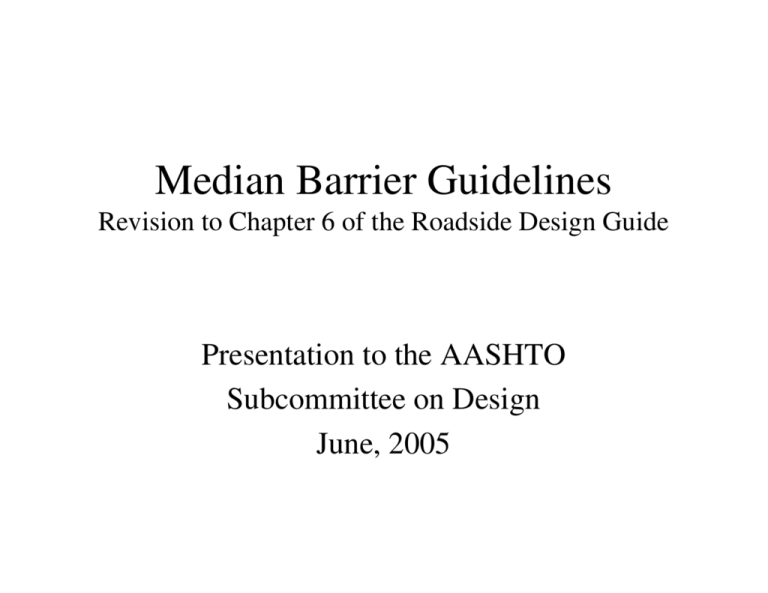Median Barrier Guidelines - Subcommittee on Design
advertisement

Median Barrier Guidelines Revision to Chapter 6 of the Roadside Design Guide Presentation to the AASHTO Subcommittee on Design June, 2005 Overview of Proposed Revision • New Guidelines for the use on median barrier • Information on high tension cable barrier • New guidance on placement of cable barrier in the median • Other minor revisions, clarifications, etc Background • NCHRP Report 54 (1968) Background • NCHRP Report 118 (1971) Background • AASHTO Guide for Selecting, Locating, and Designing Traffic Barriers (1977) NCHRP 17-14 • Selected by SCOR in March, 1995 • Original direction was to evaluate the median geometrics and tradeoffs with slope flattening National Transportation Safety Board (NTSB) Conclusion (February, 2002 ) • 12. The median barrier warrant guidance in the American Association of State Highway and Transportation Officials 2002 Roadside Design Guide is inadequate to cover today's high-speed, high-volume roadways. NTSB Recommendation • Review, with the Federal Highway Administration, the median barrier warrants and revise them as necessary to reflect changes in the factors affecting the probability of cross-median accidents, including changes in the vehicle fleet and the percentage of heavy trucks using the roadway. (H-98-24) AASHTO Strategic Highway Safety Plan • Strategy 18B: Reduce across – median crashes on freeways and arteries that have narrow medians. • NCHRP Report 500, Volume 4 Median Cross Over 40’ wide median • Many States have already revised their median barrier criteria M EDIAN BARRIER WARRANT (AASHTO 2002 Figure 6.1) 1999-2002 NJ M edian Cross Over Crashes 120000 110000 Evaluate Need for Barrier 100000 90000 80000 (AADT) 70000 Barrier Not Normally Considered 60000 Barrier Optional 50000 40000 30000 20000 10000 0 0 10 20 30 40 50 60 70 Median Width (Feet) 80 90 100 110 120 NC Cross-median Crashes 140000 120000 Evaluate Need for Barrier Average Daily Traffic (veh/day) 100000 Barrier Not Normally Considered 80000 60000 40000 20000 Barrier Optional 0 0 50 100 150 Median Width (feet) 200 250 Proposed Guidance Barrier Recommended for medians less than 50’ wide Proposed Guidance However, some flexibility is desired and the proposed guidance is intended to provide flexibility if a state finds that a barrier is not appropriate Proposed Guidance It is recognized that the increased use of median barriers has some disadvantages. • The initial costs of installing a barrier can be significant. • In addition, the installation of a barrier will generally increase the number of reported crashes as it reduces the recovery area available. • As a result, there will also be ongoing costs to repair the barrier and increased exposure of maintenance crews to traffic. Proposed Guidance • Another concern of a median barrier is that it will limit the options of maintenance and emergency service vehicles to cross the median. • In snowy climates, a median barrier may also affect the ability to store snow in the median. There may be other environmental impacts depending on the grading required to install the barrier. Proposed Guidance • For these reasons, a one size fits all recommendation for the use of median barrier is not appropriate. Proposed Guidance • For locations with medians widths between 10 m [30 ft] and 15 m [50 ft] or where the average daily traffic (ADT) is less than 20,000, these guidelines allow flexibility when a study reveals that a barrier is not appropriate (not cost effective). To apply this flexibility, states are encouraged to conduct a study, such as a benefit/cost analysis, for medians on their system to determine whether or not a barrier is appropriate in these locations. High Tension Cable Barrier • • • • Brifen Cass Marion Steel Blue Systems Cable Barrier Placement • Avoid area from 1’ to 8’ from the bottom of the ditch







